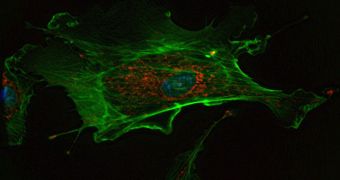Biologists have been trying to make sense of the way the membrane surrounding each and every one of our cells works for many years, but it was only now that they realized the physics underlying this behavior can be easily replicated.
In fact, this is so easy to do that anyone could construct an artificial cell membrane in their kitchen. All that is needed is one part water and two parts cornstarch.
After mixing the two chemicals together, you will notice that gently moving your fingers through the solution causes it to behave like a smooth-flowing liquid.
But when you strike it with force, it turns into a rubber-like solid, which can be used as a trampoline, provided that enough of the stuff is available.
Researchers now say that this is the same type of behavior that can be seen in cellular membranes. These structures are made up of two sheets of lipids, each of which is one molecule thick.
Experts at the University of Oregon say that the new discovery changes the way biologists look at the cellular component. In the past, scientists believed that the membrane was fluid in a classical, Newtonian sense.
But the correct term for this type of structure is viscoelastic. This means that the membrane is very fluid in its natural state, but that, once attacked violently, it turns into an effective repellent.
“This changes our whole understanding of what lipid membranes are,” says UO physics professor Raghuveer Parthasarathy, who is a member of the Materials Science Institute and Institute of Molecular Biology at the university.
“We may need to rethink our understanding of how all sorts of the mechanical processes that occur in cell membranes work, like how proteins are pulled from one place to another, how cells respond to stretching and other forces, and how membrane-embedded proteins that serve as channels for chemical signals are able to open and close,” he adds.
Details of the new investigation are detailed in the October 25 issue of the esteemed journal Proceedings of the National Academy of Sciences (PNAS).
“A lot of these mechanical tasks go awry in various diseases for reasons that remain mysterious. Perhaps a deeper understanding of the mechanical environment that membranes provide will illuminate why biology functions, or fails to function, in the way it does,” the expert adds.
The work was made possible by grant money from the Alfred P. Sloan Foundation, the Office of Naval Research (ONR), and the US National Science Foundation (NSF), Science Blog reports.
“In retrospect, we shouldn’t be surprised. Nature uses viscoelasticity in lots of its other liquids, from mucus to tears. Now we’ve found that it harnesses viscoelasticity in lipid membranes as well,” Parthasarathy concludes.

 14 DAY TRIAL //
14 DAY TRIAL //